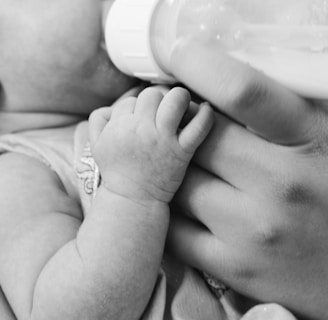Tips for Introducing a Bottle to a Breastfed Baby
2/11/20243 min read


Breastfeeding is great, right? Especially if you're lucky enough to have a baby that takes to it without any problems. But then, like all good things, maternity leave must come to an end and you'll have to entrusrsomebody else to feed your baby. You don't like this and baby doesn't either. At least you got the warning, you knew this day would come. Make sure to prepare baby for it as well. Introduce that bottle early so they aren't blindsided by the babysitter. Babies can be resistant to change, and getting them to accept a bottle can sometimes be a struggle. I introduce the bottle early (4 weeks) and my baby acted as though it was a knife I was putting in her mouth rather than a soft, silicone nipple. It took a good month of daily bottles and some creativity to get her to accept her meals from a bottle. Here are some tips that may help with the transition. Remember to be patient with baby and yourself, neither of you are enjoying this part.
🍼 START EARLY: I can't stress this enough. It's recommended to introduce the bottle when they are around 4-6 weeks old (if breastfeeding is going well- if not push it back until you have at leastb4 weeks of good latching).That way there's less pressure on you to be ready for your return to work; you'll have a little more time to try different methods and see what works.
🍼 EXPERIMENT with different bottles/nipples: There are so many variations out there. And they all claim to be "#1 rated" and "closest to breast". It's recommended to use the bottle and nipple that closest matches your own nipple and flow to avoid nipple confusion. Good luck with that, i was so confused trying to compare myself to these plastic things that all look mostly the same. I ended up buying one of each that was recommended by the lactation consultant and using a trial and error method. I had the most luck with the Philips Avent and Como Tomo bottles.
🍼 DON'T FEED BABY YOURSELF: Finally, dad gets his chance to feed baby. It's said that babies can smell mom from a couple feet away. Have someone else, your partner or a grandparent, offer the bottle while you step out for a little bit. Then talk about what worked and what didn't. This will help doubly if grandparent's are babysitting. We used to call it bottle feeding boot camp. It allowed baby to bond with other caregivers while I tried to get comfortable being away from baby. And it definitely did soften the blow when I went back to work.
🍼 CHANGE POSITIONS: Just like with breastfeeding, there are different positions to hold baby while feeding and it may take a few tries before discovering what you and baby like best. Try different holding positions, such as cradling, sitting upright, or even walking around while feeding. My husband found success having baby sit in his lap with her back againstnhis belly and facing away from him while my preferred the cradle hold. Baby may be okay with different positions with different people.
🍼 START SMALL: Begin with just an ounce or so and start/finish the feed with the breast of need be. Thinknofnit like negotiating. If able, try replacing one feed/day or every other day with a bottle feed.
🍼 WARM the milk: Baby is used to milk coming out of your breast a little warm. Just be careful to test the temperature in your wrist to make sure it's not too hot. My husband would say "urine temp" 😵💫. But, yeah, he's right - however, I still prefer to call it "body temp".
🍼 DISTRACT: Try offering the bottle during playtime or when your baby is in a calm and relaxed state. At one point, we offered baby the bottle during a bath. She just seemed so relaxed and thought we'd give it a shot. This was early on and we had been unsuccessful so far. She actually took it, we couldn't believe it! After that one, she was a little more receptive to bottles. I'm looking forward to when she's older and I can tell her about her first shower beer.
🍼 SEEK SUPPORT: Never hesitate to seek support. Reach out to a lactation consultant or join a breastfeeding support group for guidance and advice. Remember, every baby is unique, and what works for one may not work for another. Be patient, flexible, and open to trying different strategies until you find what works best for your baby. With persistence and patience, you can succeed at this and add it to your lessons learned.
